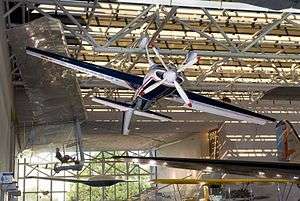Extra EA-260
The Extra 260 is a one of a kind, hand built, single-seat aerobatic aircraft derived from the Extra 230 and first flown in 1986. Designed by aerobatic pilot Walter Extra based on the layout of the Extra 230, the Extra 260 is a higher performance version of its predecessor with 60% more power and 18% increase in weight. The sole EA-260 was flown by Patty Wagstaff to victory in two U.S. National Aerobatic Championships, (1991 and 1992), and then retired for an Extra 300S. From : "Extra 260". airandspace.si.edu.
| Extra EA-260 | |
|---|---|
 | |
| Extra 260 at the National Air and Space Museum | |
| Role | Aerobatic Aircraft |
| National origin | Germany |
| Manufacturer | Extra Flugzeugbau |
| Designer | Walter Extra |
| First flight | 1986 |
| Retired | 1993 |
| Status | Smithsonian Museum |
| Number built | 1 |
| Developed from | Extra EA-230 |
Design
The Extra 260 is based on the design of the Extra 230, and the two aircraft share many similarities. The Extra 260 has a welded steel tube fuselage covered in fabric with a carbon/glass hybrid composite empennage (i.e., the tail assembly, including the horizontal and vertical stabilizers, elevators, and rudder), and a bubble canopy. The monocoque wings have a Polish pine wood spar with birch plywood skins. A symmetrical airfoil, mounted with a zero angle of incidence, provides equal performance in both upright and inverted flight. The landing gear is fixed taildragger style with composite main legs and fiberglass wheel pants. The piston-engined powerplant is a fuel-injected Lycoming AEIO-540-D4A5 and has a 4-bladed constant-speed MT composite propeller. From : "Extra 260". airandspace.si.edu.
Specifications (Extra 260 EA-260)
Data from Smithsonian Air and Space Extra 260[1]
General characteristics
- Crew: 1
- Length: 6 m (19 ft 8 in)
- Wingspan: 7.6 m (24 ft 11 in)
- Height: 1.8 m (5 ft 11 in)
- Empty weight: 522 kg (1,151 lb)
- Gross weight: 778 kg (1,715 lb)
- Powerplant: 1 × Lycoming AEIO-540-D4A5 6-cylinder air-cooled horizontally-opposed piston engine, 240 kW (320 hp)
- Propellers: 4-bladed MT constant-speed composite propeller
Performance
- Maximum speed: 405 km/h (252 mph, 219 kn)
References
| Wikimedia Commons has media related to Extra 260. |
- "Extra 260". airandspace.si.edu. Retrieved 22 June 2017.